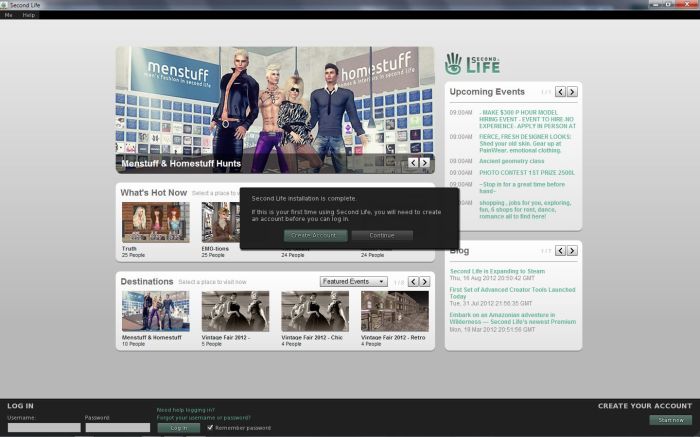At the start of the month, Hypergrid Business reported on Linden Lab’s removal of support for the –loginURI parameter from versions of the SL Viewer.
This command is most commonly used to modify the command path used to launch the viewer, allowing it to connect to grids other than Second Life. It has already been removed from the latest development ad beta versions of the viewer, and as such will find its way to the release version in the near future.
For the majority of people who use the official viewer and only access Second Life, the announcement passed largely unnoticed. Even among those who do routinely bounce between Second Life and other grids using TPVs, the impact of the change was minimal – most viewers openly supporting access to both Second Life and OpenSim grids tend to do so through the use of a grid selector / grid manager option – which remained unaffected by the change.
The Shape of Things to Come
However, the removal of support for –loginURI was the tip of the iceberg.
In April of this year, Linden Lab announced a sub-licencing arrangement involving the Havok physics engine. While there is already some Havok functionality evident in the viewer as it is (used in conjunction with mesh uploads and pathfinding), the licence arrangement enables Linden Lab to develop a library of Havok functions for the viewer. In time, this may prove to have significant benefits for Second Life; however, there is a catch.
Once the new Havok libraries are in place and available for use, the terms of the sub-licence require that any viewer accessing them only connects to Second Life. Period. Ergo, no grid selector, no grid manager and no support of –loginURI or any other means of provisioning OpenSim log-in support for such viewers.
In other words, once the arrangement is up and running, those TPVs that currently support both Second Life and OpenSim access, and which are eligible to make use of the new LL Havok libraries, have to make a choice as to their future direction:
- Do they sign-up to the new sub-licence agreement to gain access to the new libraries and completely forgo any OpenSim support they may have provided?
- Do they fork their development to provide two flavours of their viewer – one configured to access SL only and make use of the new Havok libraries, the other specifically aimed at OpenSim and unable to access the Havok functions?
- Do they abandon SL altogether and instead focus solely on OpenSim?
- Do they perhaps opt to forgo the use of the new library functions and continue “as is”, ignoring any new capabilities provisioned via the Havok libraries?
The option to fork development between SL and OpenSim probably comes down to matters of bandwidth, maintenance and audience. Does a TPV have the bandwidth to develop two flavours of viewer? Does it enjoy a sufficiently largely audience in both SL and OpenSim to warrant the time and effort needed to do so?
 Firestorm
Firestorm
The Firestorm team announced in June that they would continue to support both Second Life and OpenSim by forking the development of the Firestom viewer between the two in the near future (if this has not in fact already happened in the intervening time).
While one version of Firestorm will remain focused on Second Life, the second branch will be geared towards general support of the OpenSim platform and not incorporate code from Linden Lab that is ring-fenced by the new sub-licence arrangement.
Niran’s
In July, NiranV Dean confirmed Niran’s Viewer would not be supporting OpenSim – although the decision was possibly as much based on a personal preference as having anything to do with the upcoming Havok sub-licence situation.
Dolphin
 Now, with the new sub-licence arrangement looming, Dolphin Viewer developer Lance Corrimal formally announced on August 18th that future versions of Dolphin will be solely focused on Second Life as he doesn’t have the bandwidth to maintain three flavours of his viewer across two environments (Second Life and OpenSim). He will, however, be providing a clone of the original repository should anyone wish to fork it and make an OpenSim specific version.
Now, with the new sub-licence arrangement looming, Dolphin Viewer developer Lance Corrimal formally announced on August 18th that future versions of Dolphin will be solely focused on Second Life as he doesn’t have the bandwidth to maintain three flavours of his viewer across two environments (Second Life and OpenSim). He will, however, be providing a clone of the original repository should anyone wish to fork it and make an OpenSim specific version.
It remains to be seen if other TPVs will make formal announcements and which route they will opt to take.
Looking to the Future
Some commentators, on hearing the news regarding –loginURI, reacted negatively, with some citing the move as a further indication of the demise of SL. These reactions would appear unwarranted. It is unlikely that any split in how either Second Life and OpenSim are accessed is going to have a major impact on either the use of SL or its longevity.
Similarly, while some may be personally inconvenienced (having to move between two viewers depending on whether they are logging-in to SL or an OpenSim grid), it is hard not to see this situation as anything but beneficial for OpenSim. If nothing else, it frees those viewer developers who wish to focus on OpenSim to develop functionality and capabilities within the viewer that are specifically geared to the platform (e.g. much improved OSSL support) and unfettered from any constraints or worries about maintaining compatibility with SL (such as the 4,096-region teleport limit).





